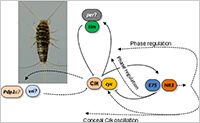The firebrat, primitive insect, exhibits a unique circadian clock resembling that of mammals
Most animals show daily rhythms that are generated by an endogenous mechanism, the so-called circadian clock, consisting of transcriptional/translational feedback loops, in which Clock (Clk) and cycle (cyc) genes are the key elements.
Although cyc is known to be expressed in a daily rhythmic manner in many insects, little is known about its regulation.
Yuichi Kamae, Outa Uryu, Taiki Miki, and Kenji Tomioka at Okayama University, have identified the orphan nuclear receptor genes HR3 and E75 as the major regulators of the rhythmic expression of cyc in a primitive insect, the firebrat Thermobia domestica, by molecular cloning and RNA interference technology. The HR3 and E75 are orthologs of mammalian clock genes, Rorα and Rev-erbα, respectively that regulate the rhythmic expression of Bmal1, a mammalian homolog of cyc.
Knocking-down of either HR3 or E75 gene was found to alter the rhythmic expression profiles of not only cyc but also other clock genes, leading to a disorganized molecular oscillatory state of the firebrat’s circadian clock. The disorganization results in a loss of behavioral circadian rhythms.
The results suggest that the HR3 and E75 genes are involved in the circadian clock as regulators of the cyc gene, like in mammals, and more importantly as phase regulators of other clock genes. They also implicate that the firebrat has a unique circadian clock in which the preservation of an appropriate phase relationship among clock genes is required for manifestation of overt behavioral rhythms.
Reference:
Authors: Yuichi Kamae, Outa Uryu, Taiki Miki, Kenji Tomioka (2014)
Title of original paper: The nuclear receptor genes HR3 and E75 are required for the circadian rhythm in a primitive insect.
Journal volume pages: PLoS ONE, 9(12): e114899.
Digital Object Identifier (DOI):10.1371/journal.pone.0114899
Journal website: http://www.plosone.org/
Affiliations: Graduate School of Natural Science and Technology, Okayama University
Figure caption: The firebrat, Thermobia domestica, and the proposed hypothesis of its circadian clock machinary.

